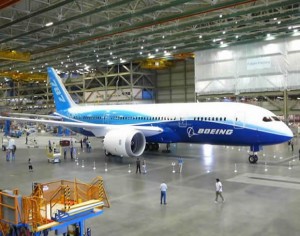San Antonio Texas, realizes commercial aviation dream

The day finally came.
Invited members of San Antonio’s business community drove to Port San Antonio on Friday and parked outside of Boeing Co.’s Hangar 400.
Many had been inside the hangar before to attend ceremonies marking government contracts with Boeing for repair, maintenance and overhaul of gray, unpainted military aircraft.
Friday was different. Inside sat a sleek, gleaming, white-painted Boeing 787, the 23rd off the assembly line in Everett, Wash. Even indoors, the Dreamliner looked like it was flying at 550 mph even though it wasn’t moving an inch.
The commercial aviation industry has arrived in San Antonio. After more than 15 years of discussing how to bring airline aircraft work here of this caliber, seeing the airplane up close was a moment to savor.
The 787 is here for post-assembly optimization and customization work before delivery this summer to Japan Airlines (JAL). San Antonio is the only city slated to do this work outside of the main 787 assembly line in Everett.
The work is high-tech stuff, involving software and electronic systems that manage the wing flaps, elevators, rudders and cabin environment systems.
Boeing officials at Friday’s ceremony seemed just as excited as the city’s business and government leaders. Boeing thinks of the 787 as the first true new aircraft of the 21st century, with its lightweight composite body that will significantly reduce fuel consumption.
The JAL plane also is the first commercial aircraft Boeing has ever sent to one of its Department of Defense depots. The oft-repeated phrase Friday was “One Boeing,” indicating the Chicago-based company’s goal to show its military and commercial divisions can work together.
Boeing looked at its sites in Washington State, California and Kansas before selecting San Antonio in 2007 for post-assembly enhancements of its 787 line. Boeing’s San Antonio hangar was large enough, but the bigger factor was the city’s ability to pull together the skilled workforce, especially people with airframe and power plant licenses.
The 2007 selection of San Antonio turns out to be a windfall for 2011. Military work at Boeing’s San Antonio center and at Lockheed Martin Corp.’s Kelly Aviation Center next door at Port San Antonio will dwindle in the coming years.
Military transport and tanker aircraft are being retrofitted with new engines that will need less frequent maintenance, repair and overhaul, even if Boeing and Lockheed Martin are able to win contract extensions.
The same is happening in the airline industry, too. The competition for both airline and military will intensify in the coming years, and San Antonio needs to develop an aerospace work force experienced in both.
Thanks to Boeing, San Antonio now can market its aerospace workers as 787-capable. That’s powerful. But the best marketing will come when the Dreamliners serviced in San Antonio are delivered to the airlines.
The work must be immaculate. “I have not the slightest fear it will be,” said Jim Perschbach, chairman of the Greater San Antonio Chamber of Commerce‘s aerospace committee.
If so, the word-of-mouth within the industry effectively will say that San Antonio does this work well. The dream of mainstream commercial aviation work in San Antonio won’t be just a dream anymore.
dhendricks@express-news.net